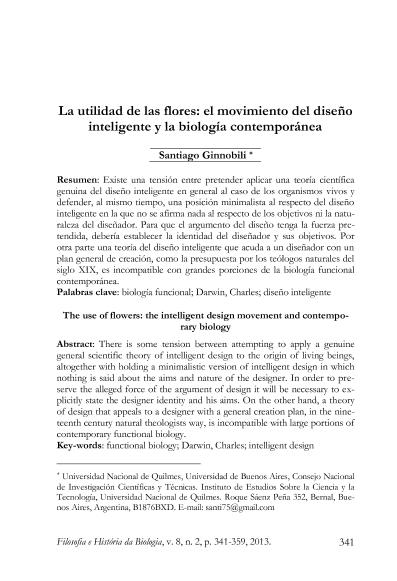Artículo
Existe una tensión entre pretender aplicar una teoría científica genuina del diseño inteligente en general al caso de los organismos vivos y defender, al mismo tiempo, una posición minimalista al respecto del diseño inteligente en la que no se afirma nada al respecto de los objetivos ni la naturaleza del diseñador. Para que el argumento del diseño tenga la fuerza pretendida, debería establecer la identidad del diseñador y sus objetivos. Por otra parte una teoría del diseño inteligente que acuda a un diseñador con un plan general de creación, como la presupuesta por los teólogos naturales del siglo XIX, es incompatible con grandes porciones de la biología funcional contemporánea. There is some tension between attempting to apply a genuine general scientific theory of intelligent design to the origin of living beings, altogether with holding a minimalistic version of intelligent design in which nothing is said about the aims and nature of the designer. In order to preserve the alleged force of the argument of design it will be necessary to explicitly state the designer identity and his aims. On the other hand, a theory of design that appeals to a designer with a general creation plan, in the nineteenth century natural theologists way, is incompatible with large portions of contemporary functional biology.
La utilidad de las flores: el movimiento del diseño inteligente y la biología contemporánea
Fecha de publicación:
09/2013
Editorial:
Associação Brasileira de Filosofia e História da Biologia
Revista:
Filosofia e História da Biologia
ISSN:
1983-053X
Idioma:
Español
Tipo de recurso:
Artículo publicado
Clasificación temática:
Resumen
Palabras clave:
Biología Funcional
,
Darwin, Charles
,
Diseño Inteligente
Archivos asociados
Licencia
Identificadores
Colecciones
Articulos(SEDE CENTRAL)
Articulos de SEDE CENTRAL
Articulos de SEDE CENTRAL
Citación
Ginnobili, Santiago; La utilidad de las flores: el movimiento del diseño inteligente y la biología contemporánea; Associação Brasileira de Filosofia e História da Biologia; Filosofia e História da Biologia; 8; 2; 9-2013; 341-359
Compartir




